.jpg)
Printing warmth -- Fusuma (sliding door) paper from Noda Print Motif Workshop
Since ancient times, the Japanese have used washi (Japanese paper) for interior accessories, such as wallpaper and hyogu (a traditional Japanese craft of mounting calligraphy, paintings, or other works of art onto scrolls, frames or folding screens). They have enjoyed the distinctive texture of natural materials as well as pictures, patterns and other decorations.
Noda Print Motif Workshop, which is run by Takuma and Aiko NODA, creates fusuma paper, wallpaper and more that add color to daily life. Unique designs are added to the works with a sense of playfulness by applying a traditional technique called karakami.
While edgy, the works created by these artists somehow make you feel a warmth.
Clues for enjoying living spaces can be found in their meticulous handwork.
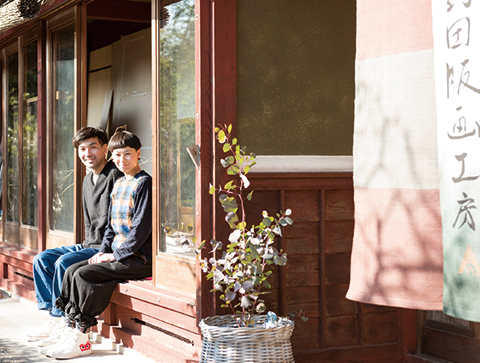
We want to pursue our own view of the world by adding new ideas to tradition.
Noda Print Motif Workshop (Higashiomi-shi, Shiga)
Takuma & Aiko NODA
Block print artist. Born in Kyoto in 1978. After graduating from Kyoto Saga Art College, Mr. Noda was trained at an established karakami workshop in Kyoto before he started to work independently in 2011. He moved to Higashiomi-shi, Shiga, and built his workshop. In addition to made-to-order fusuma, folding screens and other works, he has published his unique works by exhibiting them at exhibitions. The workshop handles most of the procedure, from the creation of woodblocks, dying paper and finishing the works as final products. Mr. Noda is mainly in charge of dying paper, printing and the finishing process. His wife, Aiko Noda, works as the designer. Her main tasks are the design and creation of woodblocks.
HP: nodahanga.com
Noda Print Motif Workshop is in Higashiomi-shi, Shiga, east of Lake Biwa. The workshop is located in a small settlement in idyllic mountains, surrounded by a rich natural environment. Takuma and Aiko NODA moved from Kyoto to this place in the spring of 2011. They purchased a 30-year-old Japanese-style house that had been vacant for around 15 years to serve as their residence and atelier. They enjoy daily life by adding small elements that reflect their sense of fun to this traditional house.
Noda Print Motif Workshop creates hyogu works that add color to living spaces as if they were cuddling residents, such as fusuma, folding screens, partitions and wallpaper. Mr. and Mrs. Noda create original works with a presence that determines the impression of each space, by adding bold colors and avant-garde designs to the traditional karakami technique.
Karakami is a kind of decorative paper that came to Japan from China during the Nara period (710 to 794). The process begins with gubiki, in which washi is dyed using a brush with a color made from pigments, such as gofun (ground seashells) and unmo (mica). The woodblock is painted with a color using a tool called furui (a kind of sieve) to ensure that the color is applied evenly. The paper is placed on the woodblock along the marks, thereby transferring the pattern to the paper. The pattern is gently transferred to the paper, as if being stroked. This creates a texture called tarashikomi, which looks as if the color were flowing. It gives the space a pearly, deep luster and unique shading. At Noda Print Motif Workshop, woodblocks are carved based on the original designs created by Mrs. Noda while Mr. Noda works on most of the processes, from dying the paper, printing a pattern on it, and finishing it as a hyogu work.
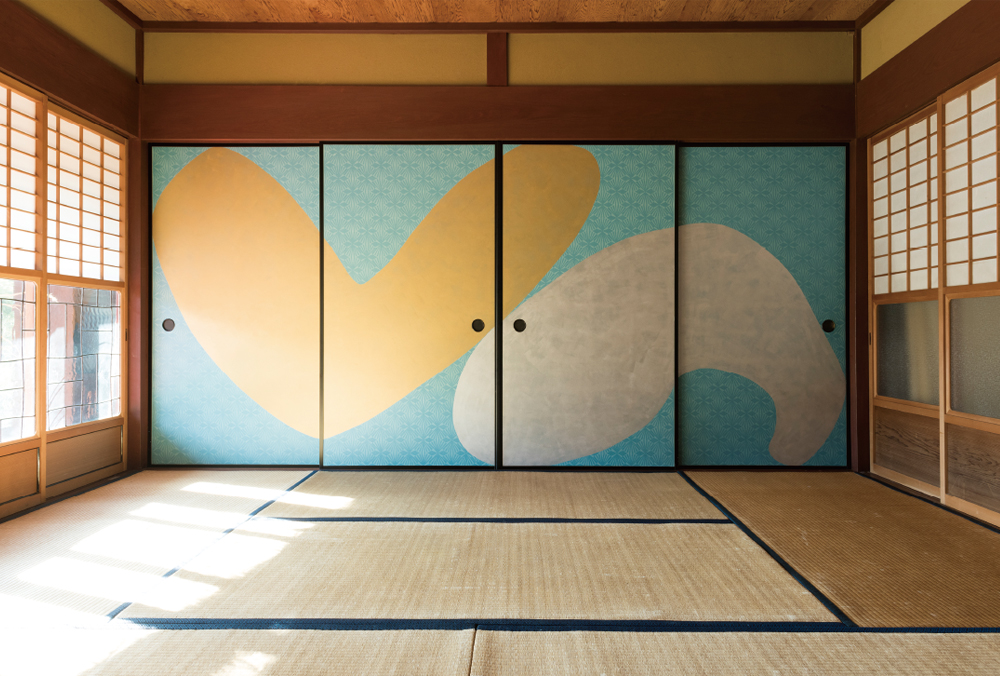
Mr. Noda learned copper engraving at Kyoto Saga Art College and received training at an established karakami workshop for five years. “Block prints have a sophisticated appeal that direct expressions in a way that paintings do not have. I encountered karakami while I was trying to figure out my future after graduation. I chose this career because I thought it was attractive that all of the processes, from the design to the creation of the woodblock, and printing are done by hand. Moreover, we are commissioned to work on the process of making fusuma as a final product.” The quality of finished karakami greatly depends on how the brush is moved, not to mention the texture and thickness of washi and the composition of the pigments from which the color is made. It requires reliable skills to embody images, experiences and finely-honed senses.
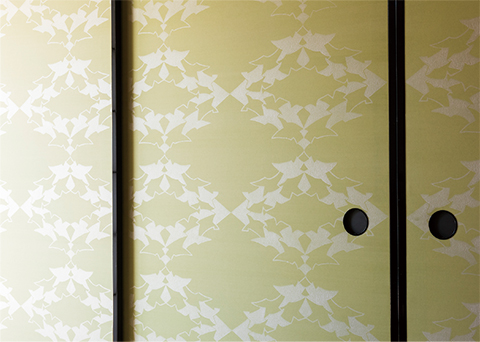
A work that has just been delivered to an acquaintance who lives in the neighborhood. It has a bird pattern on a wakana (young green) background.
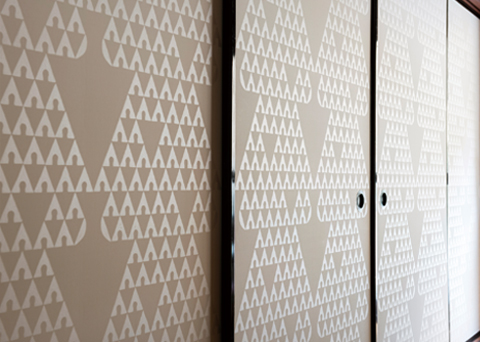
Fusuma of the workshop that has a pearly gloss.
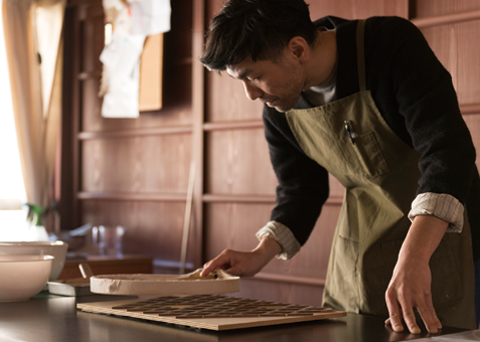
Mr. Noda applying color to a woodblock using furui.
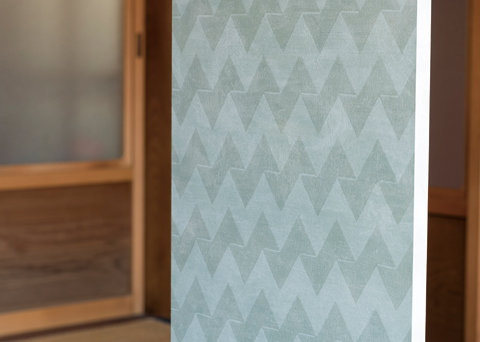
Mr. and Mrs. Noda create work other than fusuma and folding screens, such as art panels. They also stand out in traditional Japanese-style rooms.
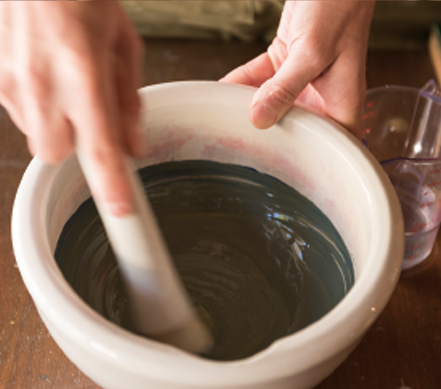
(1) Preparing pigments
Pigments such as unmo, gofun, gunjo (ultramarine) and odo (yellow ocher) are blended. They are crushed in a mortar with a muddler before glue is added to make a color with fixing power.
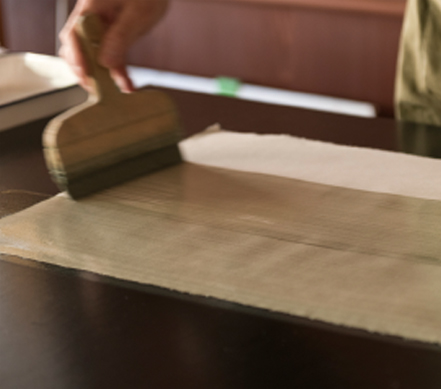
(2) Applying light make-up with gubiki
Washi is dyed with color using a brush. It is dried and then moisturized again with wet newspaper to increase the rate of absorption of pigments.
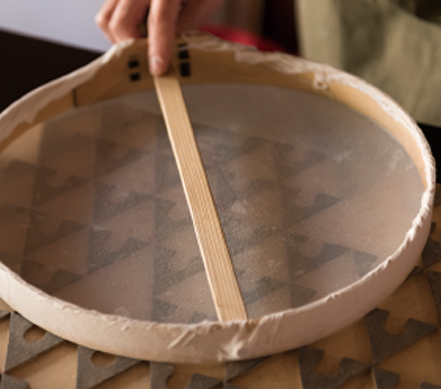
(3) Applying a color
Mr. Noda owns 20 to 30 types of woodblocks. Use of furui, a tool for applying color to a woodblock, enables him to apply it evenly and more efficiently than with a brush.
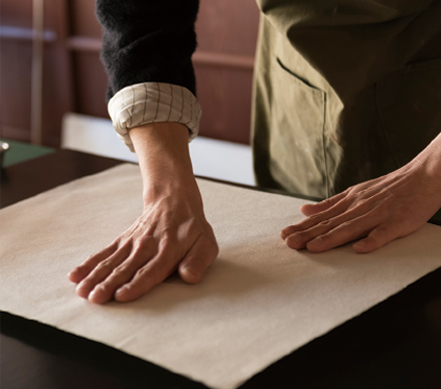
(4) Printing the pattern on the paper
Washi that has finished gubiki is placed on the woodblock along the marks. The pattern is transferred to washi by gently stroking it by hand.
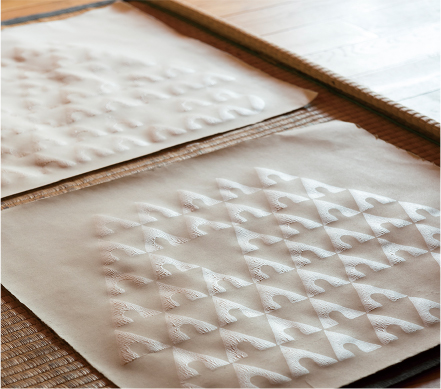
(5) Completion
In the process of making a sheet of fusuma paper, the same steps are repeated using a large sheet of washi and moving the woodblock.
“The paper I make may be heretical to some people.” Karakami as traditional crafts for interior decoration has been passed down by maintaining traditional patterns, colors, tools and procedures. “Of course, those techniques are rational, but I believe that the important point is not the process, but the final product. I use the basic elements of traditional crafts as the base. However, I believe that I cannot create something new unless I alter such elements, reflecting my own interpretation. I would like to pursue things that we find cool and expressions that resonate with those who see them while valuing the beauty of karakami.”
Mr. Noda’s out-of-the-box thinking is also reflected in his choice of paper as a material. While the paper that is often used for Kyoto karakami is torinokogami from Echizen (old name of northern Fukui), Mr. Noda also uses awagami from Tokushima and Naruko washi from Shiga. “The important points are the color absorbability, degree of water-shedding property, surface texture and thickness of paper. In addition to washi made for fusuma, I want to try using various types of paper from a flexible point of view.”
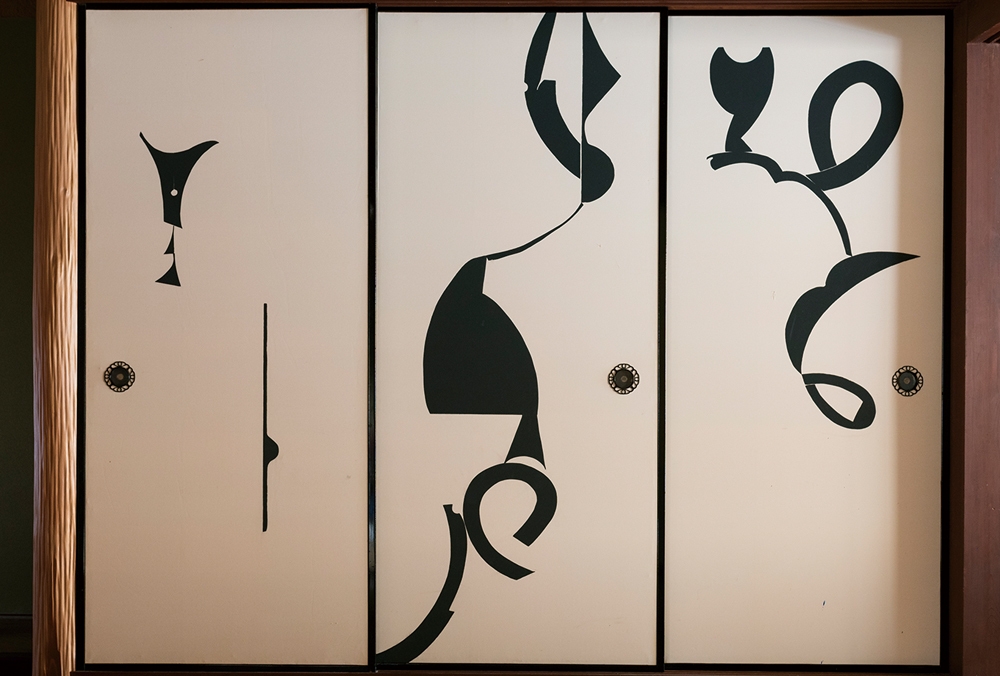
This modern design, which expresses the dynamic movement of the human body, was created by Mrs. Noda
Another factor that makes fusuma paper from Noda Print Motif Workshop highly acclaimed are the pictures and designs. After Mr. and Mrs. Noda determine the concept for each work, Mrs. Noda makes the design based on her stock of sketches. “One group of sketches consists of patterns created with the motif of the nature that we see in the village forest daily. The other is the body series, which I created through the abstraction of the organic movement of the human body. I created it by drawing inspiration from contemporary dance. I took cues from uncanny movements and dynamism of the dance,” said Mrs. Noda. The majority of patterns used for karakami are traditional ones created with the motif of the beauty of nature or regular geometric patterns. Noda Print Motif Workshop adds unconventional new feelings and a contemporary approach to good old things and has thereby established its originality.
Taking a different direction from designs with progressive, innovative impressions, their works somehow make you feel a gentleness and warmth. The highly poetic touch, which makes you feel as if you were looking at a picture that is in harmony with the space, is also unique to Noda Print Motif Workshop. “We have also created many works by adding a theme to the design. When we custom-make a work, we create its design based on what we are told by the customer. Otherwise, there are an increasing number of cases where I take a cue from what I see and hear as I raise my child, such as old tales and myths,” said Mrs. Noda. Because she is the parent of a young child as well as an artist and she expresses her affection as a parent who warmly watches her child grow, the works make you feel a sense of warmth and comfort.
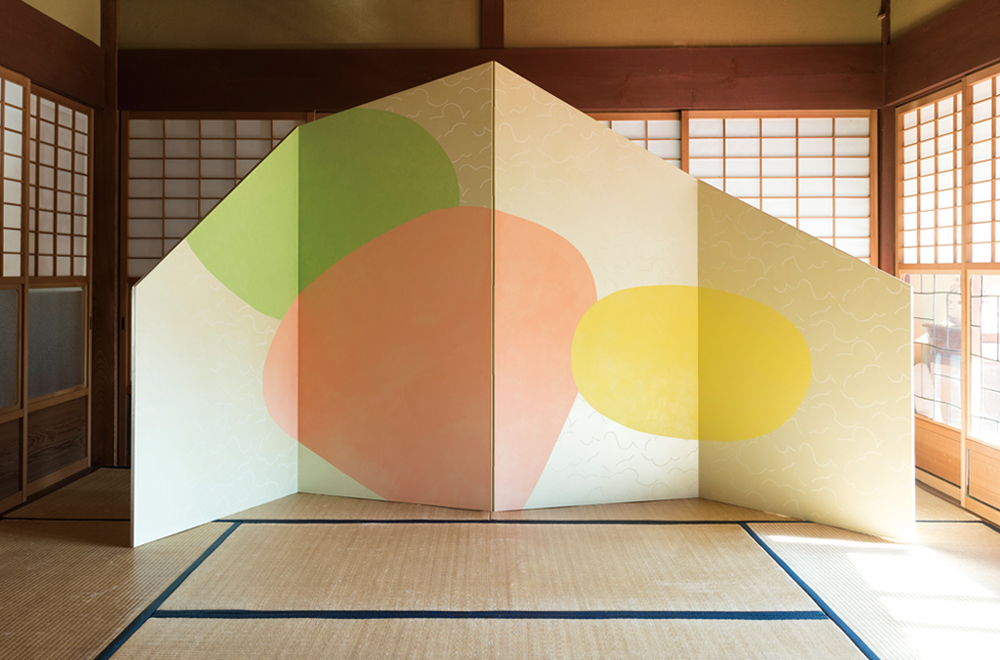
A folding screen titled “Play” that was exhibited at the Biwako Biennale 2016. It has a background pattern that was created with the motif of clouds and mountains reflected on the surface of rice paddies. The children playing vigorously are expressed in pastel colors, including a warm green and orange. Mr. and Mrs. Noda created a total of five mountain-shaped, four-panel folding screens of different heights, which were designed with the motif of mountains in Shiga. The screens are also designed in a way that their heights and patterns are in harmony with each other, even when they are placed at random.
While using traditional techniques, Mr. and Mrs. Noda continue to pursue expressions that add color to life. “Fusuma has a large surface area and can therefore be the main element of a room. This is why we value the feeling that we are designing the overall space. We would like to create works that appeal to you and make you feel as if you were talking with them at a glance.”
It soothes you without saying anything, just by being there. It is a low-profile but essential element to your daily life. Fusuma paper created cordially by Mr. and Mrs. Noda has the capacity to harmonize with any space and is filled with an essence that enriches your mind with the idea of applying art to everyday life.
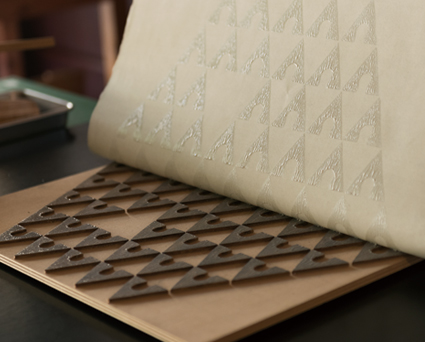
Pre-Biwako Biennale 2018
■ Period: May 10 (Thu) - June 15 (Fri) (planned)
■ Venue: Manila House (Manila, the Philippines)
BIWAKO Biennale 2018 “Kizashi~Beyond”
■ Period: September 15 (Sat) - November 11 (Sun) *Closed on Tuesdays
■ Venue: 11 venues in the old town district of Omihachiman-shi, Shiga (planned)
Contact for inquiries
Secretariat of Biwako Biennale
TEL: +81-748-36-3766
HP: energyfield.org/biwakobiennale/
